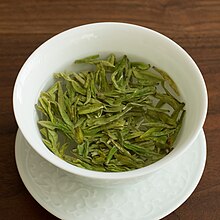| Chinese tea | |||||||||||||||||||||
|---|---|---|---|---|---|---|---|---|---|---|---|---|---|---|---|---|---|---|---|---|---|
 Longjing tea being infused in a gaiwan | |||||||||||||||||||||
| Traditional Chinese | 茶 | ||||||||||||||||||||
| Simplified Chinese | 茶 | ||||||||||||||||||||
| |||||||||||||||||||||
Chinese teas can be classified into six distinctive categories: white, green, yellow, oolong, black and post-fermented. Others add categories for scented and compressed teas. All of these come from varieties of the Camellia sinensis plant. Most Chinese teas are cultivated and consumed in China. It is commonly available in Chinese restaurants and grocery shops worldwide. Green tea is the most common type of tea consumed in China.
Within these main categories of tea are vast varieties of individual beverages. Some of the variations are due to different strains of the camellia plant. However, the largest factor in the wide variations comes from differences in tea processing after the tea leaves are harvested. White and green teas are heat-treated (杀青; 殺青; shā qīng) soon after picking to prevent oxidization, often called fermentation, caused by natural enzymes in the leaves. Oolong teas are partially oxidized. Black teas are fully oxidized. Other differences come from variations in the processing steps.